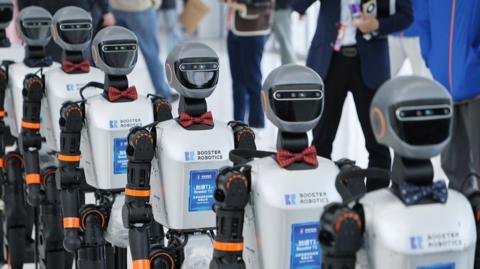The Humanoid Robot Race: Who Will Lead the Future of Automation?
In a cutting-edge showcase at the Hannover Messe in Germany, the Unitree G1 humanoid robot steals the spotlight. At approximately 4’3” (130cm), this affordable robot is attracting attention with its surprisingly fluid movements, engaging visitors who eagerly attempt to interact with it. This demonstrates the growing interest in humanoid robots, which hold promise for various applications, including both industrial and domestic tasks. However, the article highlights the challenges still faced, particularly in the realm of artificial intelligence that enables these robots to perform complex tasks safely, especially in unpredictable environments like homes or restaurants.
Several companies across the globe are pouring resources into humanoid robot development, but Elon Musk’s Tesla has notably committed to creating thousands of viable humanoid robots named Optimus, aimed primarily at enhancing productivity in Tesla factories. Other automakers like BMW and Hyundai are following suit with their own developments, signaling a significant shift toward integrating robots in manufacturing environments.
Thomas Andersson, founder of research firm STIQ, notes that Chinese companies are poised to dominate the humanoid robot market, largely due to their extensive supply chains and financial backing from the government. This opens concerns for companies from the U.S. and Europe, which may struggle against competitive pricing and manufacturing capabilities. The article elaborates on how some European companies, like Bristol-based Kinisi, are adapting by integrating production with cost-effective strategies, such as sourcing sub-components from Asia while simplifying their robot designs to fit specific industrial uses.
Despite these advancements, experts like Bren Pierce acknowledge that the dream of humanoid robots becoming commonplace in homes is still a long way off, with optimistic projections suggesting it might take 10 to 15 years for such robots to widely achieve functionality in domestic settings.
As a conclusion, while the race to develop humanoid robots intensifies, it is clear that significant technological and practical hurdles remain before these machines can transition from factories to everyday life.

